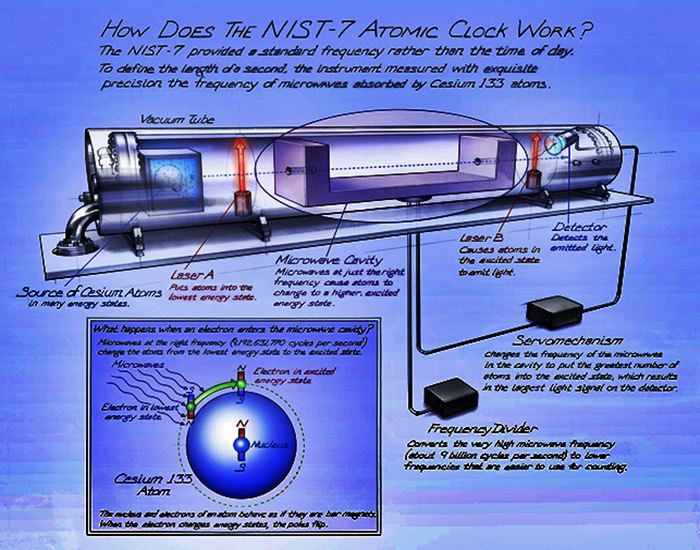Time in a Bottle
Clocks and Watchers
=================
For centuries , people mostly measured time by the motion of the Sun or by large,
mechanical pendulum clocks. The need for accurate and portable time measurement
arose only in the 17th and 18th centuries, when long-distance sea navigation necessitated
a method of calculating longitude. Until recently, all clocks and watches were driven mechanically,
but electronic timekeeping is now widespread.
The first accurate clocks and watches were built in the mid-1700s for navigation , when long
sea voyages were becoming common. Although sailors could work out their latitude from the stars,
the only practical way to calculate longitude was to know the time at the home port wen it was noon
on the ship, midday is four minutes earlier or later for each degree of longitude east or west.
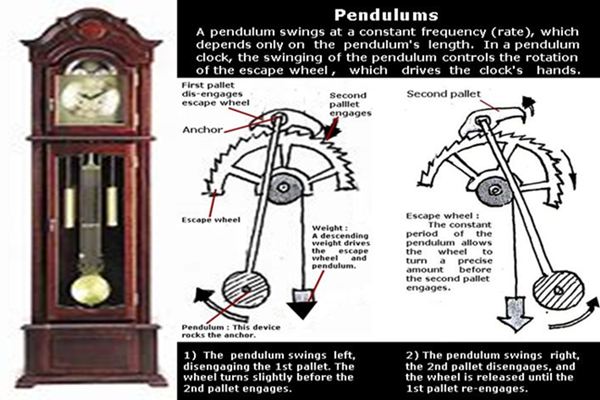
Mechanical and Quartz Watches
===========================
Mechanical clocks and watches are powered by springs or moving weights. The best spring-driven
mechanical clocks of the early 20th century gained or lost up to one tenth of a second per day.
Quartz clocks and watches are battery powered and are accurate to just one-thousandth of a
second per day. This accuracy is possible because they use stable electronic oscillations instead of
springs or a pendulum, and so are not subject to physical disruption from heat and friction. Some new
quartz watches have no batteries, instead, they generate electricity using a swinging weight powered
by the wearer's motion. The most accurate clocks are atomic clocks. They are used to set a universal
standard of time, which is essential for industry and telecommunication.
How Mechanical Watches work diagram :
-----------------------------------------------------------
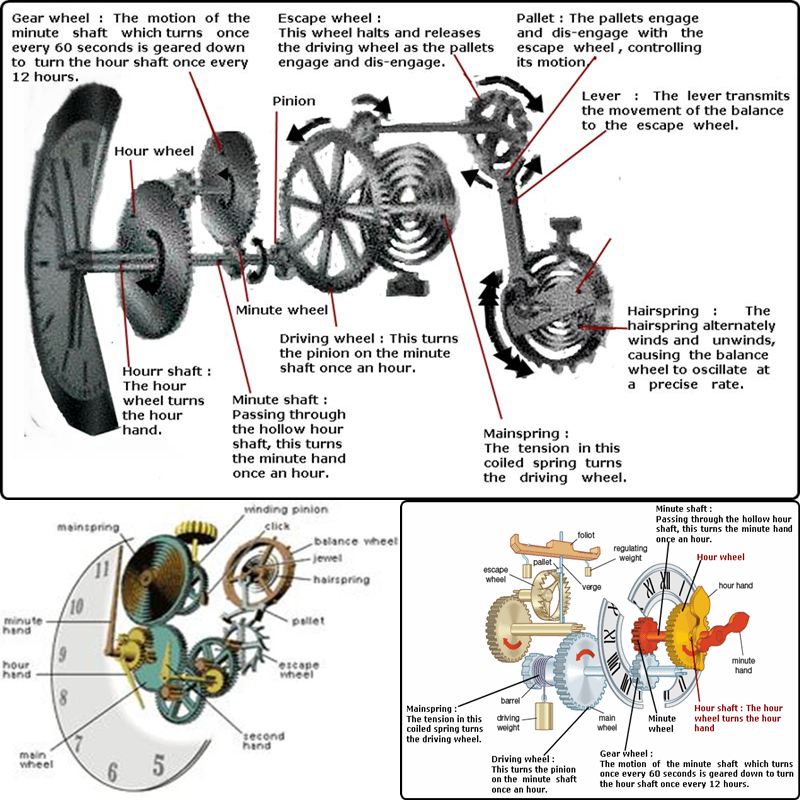
How Quartz watches work diagram :
----------------------------------------------------
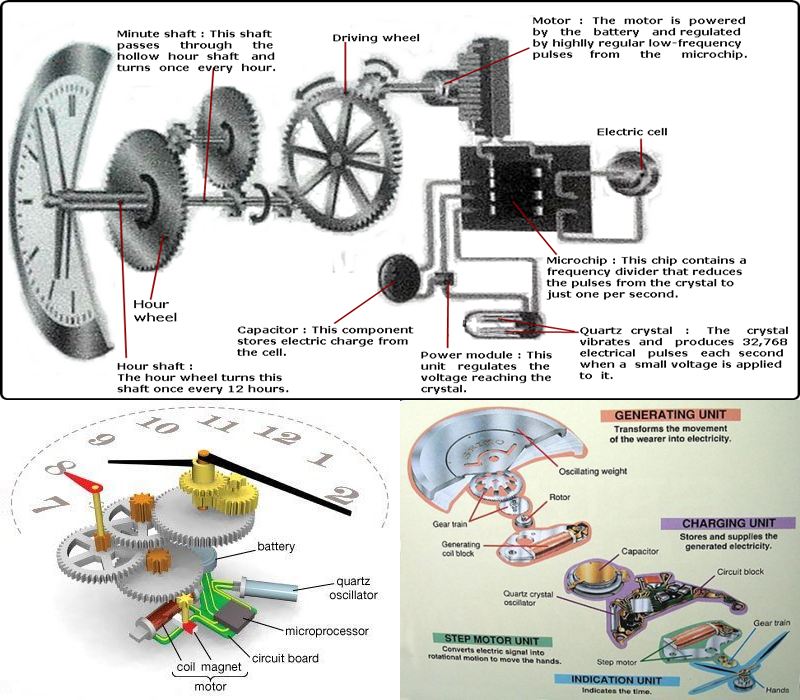
Self-charging Quartz Watch (Kinetic design)
====================================

Atomic Clocks
===============
Clocks measure time by counting off regularly repeated events, such as the
Sun's motion across the sky, a pendulum's swing , or a quartz crystal's oscillations.
The more frequent the event, the greater the potential accuracy of the clock. The
most accurate timekeeping devices are atomic clocks, which are regulated by
microwaves oscillating billions of times each second.
Most atomic clock use atoms of cesium-133, an isotope of cesium. These atoms
have two "spin states", according to whether the outermost electron is spinning in
the same (parallel) or opposite (anti-parallel) direction as the atom as a whole.
These spin states have slightly different energies, and if microwave radiation of
precisely the right frequency hits the atoms, they will flip from one state to the other.
Cesium clocks are designed to "lock" an oscillator to this frequency, called the
transition frequency, of 9,192,631,770 Hz.
In a cesium clock, atoms are separated according to their spin state, then exposed
to radiation from a microwave oscillator. The detector counts how many atoms have
changed spin state. The greater number of atoms change spin states when the
microwaves are precisely tuned to the transition frequency. A computer uses signals
from the detector to maintain the correct oscillator frequency, and pulses from the
oscillator can be timekeeping , to the extent that one second is now defined in terms
of the spin transition frequency of cesium-133 atoms.
Atomic clocks provide the timekeeping standard not just for scientific research, but also
for the world's communication and transportation networks. The Globak Positioning System
(GPS) , a satellite-based navigation system, relies on the accuracy of atomic clocks to fix a
user's position to within a few inches.
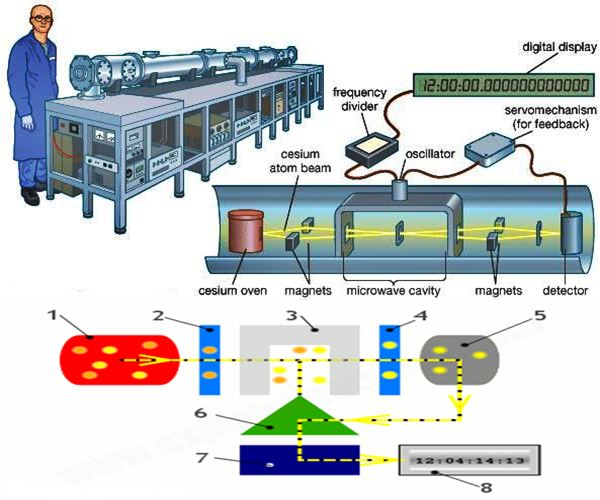
Cesium Clock
================
In a cesium atomic clock, a sample of cesium-133 is heated in an oven. Cesium atoms
boil off the sample and emerge from the oven at high speed. These are focused by
magnets into separate beams according to their spin state. The atoms pass through a
microwave cavity, where most of them are flipped into the opposite spin state. The atoms
are then deflected by a second set of magnets so that only the flipped atoms pass into a
detector. A computer uses the detector signals to "lock" the microwave frequency.
The entire clock is contained in an evacuated chamber.
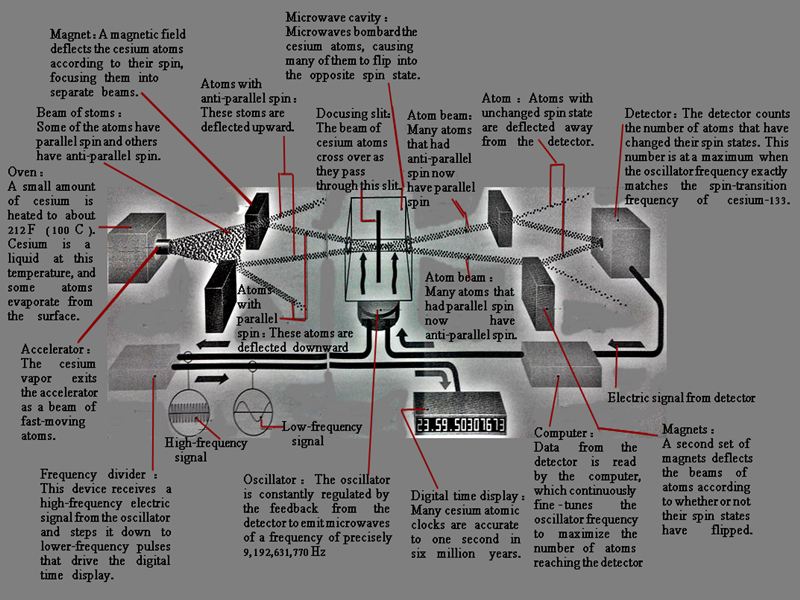
NIST-7 Atomic Fountain
==========================
Currently, the most accurate timekeeping device is a type of atomic clock called the
"atomic foundation", which tunes into the spin transition frequency of cesium-133 atoms,
as do other atomic clocks. Its great accuracy is obtained by using lasers to trap and cool a
"packet of cesium atom to just above absolute zero (the lowest possible temperature).
The latest model , the NIST F-1, is accurate to one second in 20 million years.
